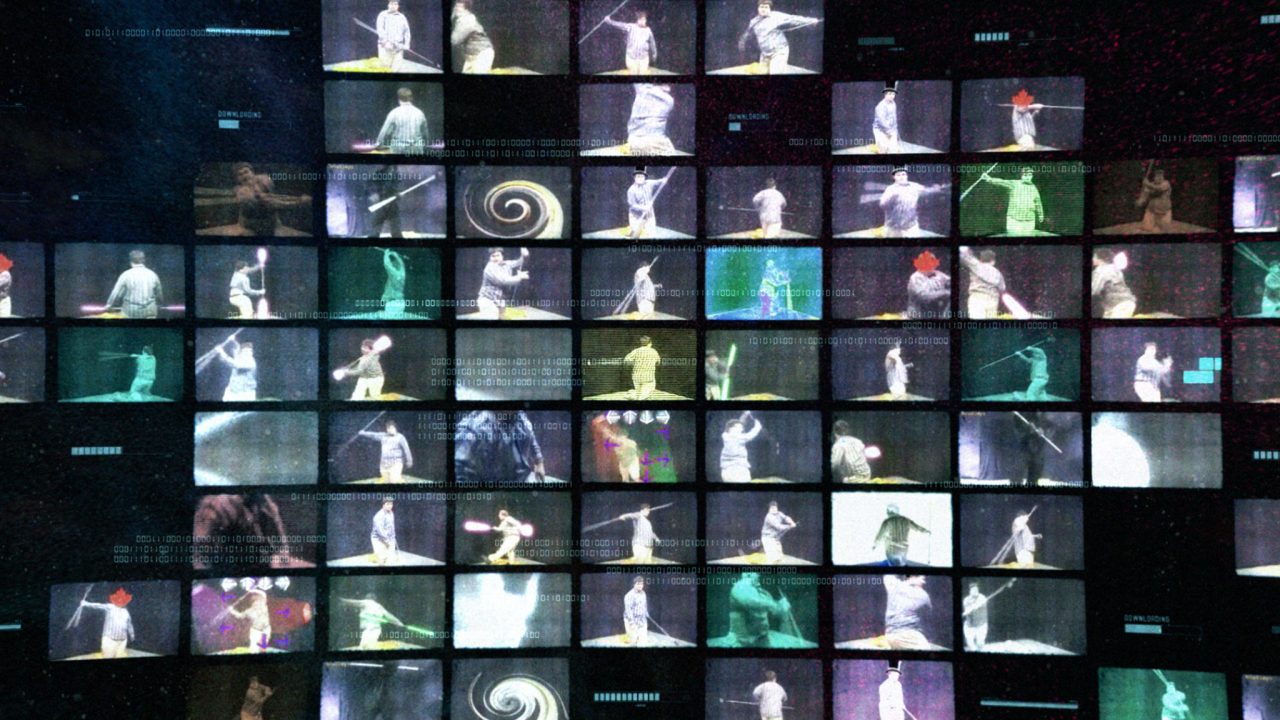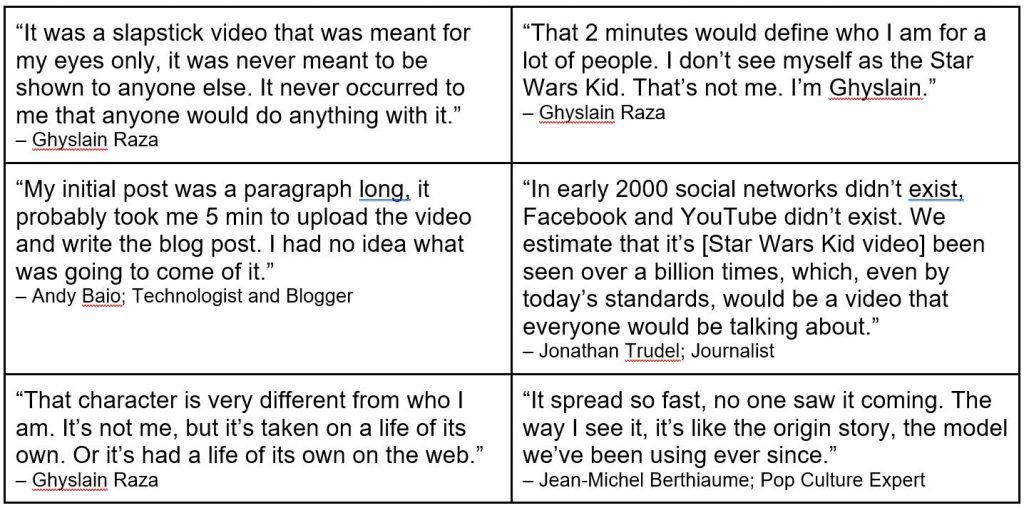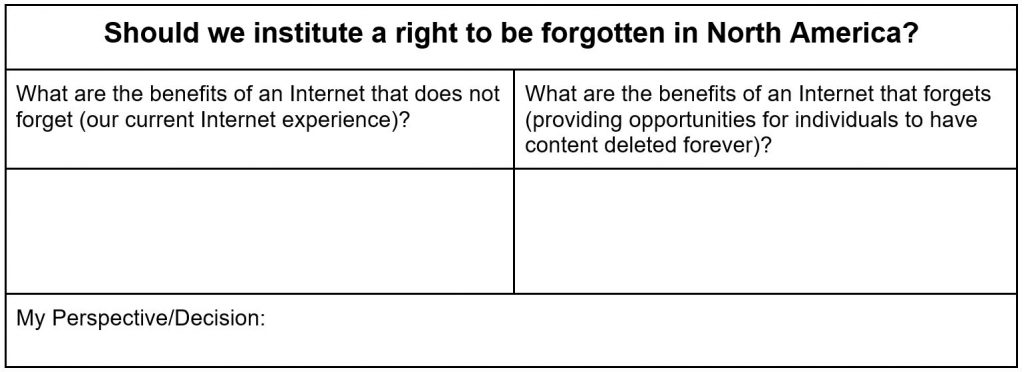
Mini-Lesson for Star Wars Kid: The Rise of Digital Shadows
Mini-Lesson for Star Wars Kid: The Rise of Digital Shadows
Mini-Lesson for Star Wars Kid: The Rise of Digital Shadows
School Subjects:
- Heath/Personal Development – Bullying & Discrimination, Healthy Relationships, Identity
- Media Education – Documentary Film, Internet, Journalism/News, Popular Culture
- Technology Education – Communications and Technology
- Social Studies – Contemporary Issues, Social History
Ages: 12-14
Star Wars Kid: The Rise of the Digital Shadows, Mathieu Fournier, provided by the National Film Board of Canada
Keywords/Topics: Consent, Social Media, Technology and Innovation, Cyber-bullying, Identity, Self-Esteem, Media Ethics, Privacy, Online Relationships, Digital Environment
Overarching Question: How has the rise of social media and digital technology used entertainment and sensationalism to overshadow responsibility, human dignity and human rights?
Educational Synopsis:
“I’m not here to sermonize, that’s not what this is about. Rather, I want to start a dialogue.”
– Ghyslain Raza
Star Wars Kid: The Rise of Digital Shadows is a human story intended to begin a dialogue about the complex and ever-changing relationship we have with social media and digital technology. It is the story of a 14-year-old boy caught up in the rise of the viral video phenomenon as it was just beginning in 2003. Now almost 20 years later, we are able to follow Ghyslain back to the origins of the Star Wars Kid, as he bravely navigates the pain of his past, bringing humanity back into focus. Students, as well as educators, will be challenged by this film to explore how they themselves have been desensitized to the widespread impact of sharing, liking and posting content online. The film also peels back the layers of how media platforms can create caricatures of our everyday lives without any accountability to the individuals behind the characters they create.
For many of us, the ongoing viral media phenomenon continues to dull our awareness of the deep impact online media can have on those involved. We have been witness to and have heard many reports of how youth can be harmed by social media. It’s important that Ghyslain’s story is not positioned as “bad kids using harmful technology to bully.” Too many messages and lessons on cyberbullying focus on naming bad behaviour and not on recognizing the humanity behind both the bully and the victim.
Activity 1: Privacy and Consent
In this first activity, students will explore consent and what rights we have as individuals to determine how and when personal information is used. Through this first clip, students will be introduced to the beginnings of the Star Wars Kid and the emerging impact of the media’s manipulation of the famous two-minute video.
Quote “Walk” and Reflection
Part 1
After watching the clip, post the quotes around the room, or create a poll or slide deck with each quote to share virtually with the class. Have students select a quote that stands out to them. Based on the quote they chose, move students to virtual breakout rooms or have them sit in groupings to discuss the following questions:
- What was it about the quote you chose that stood out to you? What did you find interesting or challenging about it?
- How does the quote impact your perspective of Ghyslain’s story so far?

Follow the group discussions with personal reflection time. Share the following quotes from the Privacy Commissioner’s Office prior to giving students time to reflect:
“‘Personal information’ means recorded information about you as an individual. It may include your name, address, sex, age, education, and medical or employment history. Privacy is a fundamental right. In order to protect that right, public institutions are required by law to protect your personal information, and to follow strict rules when collecting, using and disclosing your personal information.”
– Information and Privacy Commissioner of Ontario
“Consider the privacy of others and get their consent before you share their photos or other personal information online. When you post about friends or family, or tag them in images, it affects their privacy, too. When posting pictures that involve other people, judge if it’s appropriate, or if there are any potential negative consequences.”
– Office of the Privacy Commissioner of Canada
Using the above statements, provide 10–15 minutes for students to individually reflect on the following questions. Educators can also use this template to make a copy for each student and share in their online learning platform.
- How did the absence of Ghyslain’s consent when the video was posted contribute to a false story being told about him? How were Ghyslain’s rights to privacy neglected?
- If “power” is the ability to influence the behaviour of someone else or events that occur, who holds the power in Ghyslain’s story so far? What factors took away Ghyslain’s ability to have power over his own story?
- What can we do to protect how our own stories are told?
Part 2
Post the overarching/guiding question in the chatbox of your video conferencing platform, and/or share the quote with the whole class for discussion. Have students think about the various ideas that came through the discussions and reflection to provide initial thinking about the overarching question:
- How has the rise of social media and digital technology used entertainment and sensationalism to overshadow responsibility, human dignity and human rights?
Summary
Digital content, and the tools we use to access and create it, can have a lasting impact on the lives of others. During conversations with students in this activity, it’s important to note that all online content has made its way to the web through human action. This means that online content also mirrors the biases and views of those making decisions to post the content. When accessing or sharing online content it’s crucial to ask critical questions such as: Who is sharing the post? What might their purpose be in sharing the content? Who is benefitting from the content being posted?
Additionally, we can take actions to protect our own personal information and that of others by:
- ensuring consent before posting any content;
- thinking about the long-term implications of videos and photos of ourselves and others we share through social media platforms or messaging/texting;
- recognizing that regardless of the audience you choose for your posts, the media platforms still collect everything you post. While you may use tools to delete or hide information, data posted online can persist in different places. Permanent removal can be difficult if not impossible.
(Adapted from the Office of the Privacy Commissioner of Canada)
Activity 2: The Global Schoolyard
In the physical schoolyard, bullying often happens through a power imbalance between students, teachers and/or administrators in schools. As the digital environment has expanded physical schoolyards to a global scale, a power imbalance between victim and bully can be further amplified to involve companies and media organizations that would otherwise have no stake in local incidents. The following activity guides students in analyzing the impact of the globalization of the schoolyard and the responsibility of all stakeholders within digitally connected communities.
While watching the next clip, have students jot down all the other roles (e.g., journalist) that were brought into the story of the Star Wars Kid after it was posted online.
Group Brainstorm
Share the chart below with students and have them collaborate virtually in a document or digital whiteboard (e.g., jamboard). A Google Jamboard template has been provided.
Have students add the role (e.g., journalist), the actions they took, possible motivations, and the impact the actions had on Ghyslain.

Summary
The spark for Activity 2 came from a quote in the film from pop culture expert Jean-Michel Berthiaume, who stated:
“We came to see that the web was the global version of that same schoolyard… There was always a chance that you’d be exposed and that you’d become an outcast or a joke. And that was really scary.”
As many of us will continue to be pulled into the lives of others through the expansion of the schoolyard to digital spaces, we can also take collective actions to value the lives put at risk by others. Ghyslain challenges all of us to practise “compassionate inaction” when tempted to post, share or like potentially harmful content. Even if we aren’t sure that the content is harmful, inaction, as a first response, could lessen the negative impact.
Activity 3: Should the Internet Forget?
In this activity students will hear from two Internet experts with very different experiences growing up with media. Each perspective provides a different view on the role of the Internet during the formative years of adolescence. Students will consider the “right to be forgotten” and the role the Internet has played in archiving our lives.
Differing Perspectives
In 2014, the European Union passed legislation that gives individuals the right to be forgotten by having certain online content removed. A law like this might have changed Ghyslain’s experience significantly. Should we institute a right to be forgotten in North America?
In this thinking activity, students are challenged to consider the benefits of both an Internet that forgets and one that does not. Provide time for students to work in pairs or individually as they consider the benefits of both perspectives. Have them review the benefits of the differing perspectives to develop their own decision on the issue. Educators may choose to have students share their thinking and see if it’s possible for the class to come to a consolidated decision.

Summary
Human relationships are complex, and the way we socialize within these relationships will continue to evolve and change. Despite the hardships and hurt that Ghyslain experienced, the final scene in the film recentres the sobering reality of the challenges of growing up in both a physical and digital environment:
“We can all say, ‘I would never have done that.’ But in fact, who knows? If someone like Andy, who’s a good person, can make such a mistake, there’s no guarantee we wouldn’t have done the same.” – Ghyslain Raza
Stories like these challenge the binaries of right and wrong or good and bad, encouraging compassion towards all involved. As author Kate Eichhorn points out in the film, “The platform doesn’t care what the content is as long as you are posting it, and if others engage with it.” The pressures youth feel today to socialize by creating, posting or sharing content online should not be minimized or overlooked. Social media platforms manufacture social experiences that make it easy to prioritize attention over compassion. These platforms do not survive on compassionate inaction, but rather impulsive reactions. We need to talk about this more often.
Take Action: Extending the Dialogue
Christian Bouchard, Ghyslain’s friend, shared this idea in the film: “Where the danger is, also grows the saving power.” Star Wars Kid: The Rise of Digital Shadows was Ghyslain’s action to take back agency over his own story, using the same cameras and platforms that generated the harm to start new conversations.
Encourage students to follow Ghyslain’s lead. What actions could the class, school or community take to extend the dialogue that Ghyslain began?
Step One: Revisit the overarching question in the lesson and have students build on their ideas from Activity 1:
How has the rise of social media and digital technology used entertainment and sensationalism to overshadow responsibility, human dignity and human rights?
Have students consider the tactics that media platforms employ to encourage us to upload, post and share content in order to generate attention in their platform.
Step Two: Have students think about the dialogue that Ghyslain began in the film. What conversations was he hoping to start? What do they think is important and/or relevant to their experiences socializing within the digital environment that could extend the dialogue Ghyslain began? How can social media encourage ongoing and important conversations about responsibility and human rights?
Step Three: Work in small groups to generate actions that the class could take to further conversations about the ideas they came up with in Step Two. Consider whether using social media platforms is appropriate to extend opportunities for conversation. Have groups share their “take action” ideas with the class.
Some ideas could be:
- share the film through a school social media account accompanied by student-generated posters or PSAs highlighting student-created messages encouraging others to hear Ghyslain’s story;
- create a “Compassionate Inaction” campaign at your school, encouraging students to take a break from posting or sharing on social media;
- have students share important discussion topics through school announcements to encourage more classrooms to engage in these conversations.
NOTE: Educators should not encourage students to set up social media accounts to participate in this activity. School boards often have guidelines on the use of social media in educational contexts. If using social media is appropriate for the activity generated by the class, consider using a school or classroom account.
This mini-lesson was written by Jon Lewis. Jon is passionate about art and design and the role of technology in amplifying opportunities for student expression. He has been an Ontario educator for the past 15 years and currently works as a K-12 curriculum coordinator, supporting the use of digital platforms within a pedagogical context. Jon resides in Barrie and is an active member in promoting local arts as the cofounder of a community-based arts and educational space.
Pour lire cet article en français, cliquez ici.
Discover more Mini-Lessons | Watch educational films on NFB Education | Watch educational playlists on NFB Education | Follow NFB Education on Facebook | Follow NFB Education on Pinterest | Subscribe to the NFB Education Newsletter



